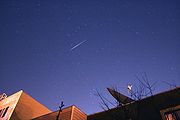
Satellite flare
Encyclopedia
 |
 |
 |
Satellite flare (also known as satellite glint) is the phenomenon caused by the reflective surfaces on satellites (such as antennas
Antenna (radio)
An antenna is an electrical device which converts electric currents into radio waves, and vice versa. It is usually used with a radio transmitter or radio receiver...
or solar panel
Photovoltaic module
A solar panel is a packaged, connected assembly of solar cells, also known as photovoltaic cells...
s) reflecting sunlight directly onto the Earth below and appearing as a brief, bright "flare".
Iridium satellite flare

Iridium satellite constellation
The Iridium satellite constellation is a large group of satellites providing voice and data coverage to satellite phones, pagers and integrated transceivers over Earth's entire surface. Iridium Communications Inc...
have a peculiar shape with three polished door-sized antennas, 120° apart and at 40° angles with the main bus. The forward antenna faces the direction the satellite is traveling. Occasionally, an antenna reflects sunlight directly down at Earth, creating a predictable and quickly moving illuminated spot on the surface below of about 10 km diameter. To an observer this looks like a bright flash, or flare in the sky, with a duration of a few seconds.
Ranging up to -8 magnitude
Apparent magnitude
The apparent magnitude of a celestial body is a measure of its brightness as seen by an observer on Earth, adjusted to the value it would have in the absence of the atmosphere...
(rarely to a brilliant -9.5), some of the flares are so bright that they can be seen in the daytime; but they are most impressive at night. This flashing has caused some annoyance to astronomers, as the flares occasionally disturb observations and can damage sensitive equipment.
When not flaring, the satellites are often visible crossing the night sky at a typical magnitude of 6, similar to a dim star.
Viewing satellite flares
While satellites may be seen by chance, there are websites which provide location specific information as to when and where in the sky a satellite flare may be seen.External links
- http://docs.google.com/viewer?a=v&pid=sites&srcid=ZGVmYXVsdGRvbWFpbnx0b21nYWxlaXNlfGd4OjQ4NmUxMmEwOTk5ZmM0ZmM Dr Tom Gale's guide to observing Iridium Flares and other artificial satellites.
- Heavens Above predicts when Iridium flares are visible from your location
- Iridium flares iPhone App Free App to predict Iridium flares on an iPhone or iPad
- Iridium flares widget for Mac OS X Download free widget to get predictions based on heavens-above.com data
- Iridium flares widget for Opera community widgetWeb widgetIn computing a web widget is a software widget for the web. It's a small application that can be installed and executed within a web page by an end user. They are derived from the idea of code reuse. Other terms used to describe web widgets include: portlet, gadget, badge, module, webjit, capsule,...
for OperaOpera (web browser)Opera is a web browser and Internet suite developed by Opera Software with over 200 million users worldwide. The browser handles common Internet-related tasks such as displaying web sites, sending and receiving e-mail messages, managing contacts, chatting on IRC, downloading files via BitTorrent,...
BrowserWeb browserA web browser is a software application for retrieving, presenting, and traversing information resources on the World Wide Web. An information resource is identified by a Uniform Resource Identifier and may be a web page, image, video, or other piece of content... - IridiumFlares prediction software (Java application)
- Iridium page at Visual Satellite Observer's Home Page Images and further description of Iridium flares
- Iridium Flares Podcast on 14 July 2011 from 365daysofastronomy.org PreviSat Software

